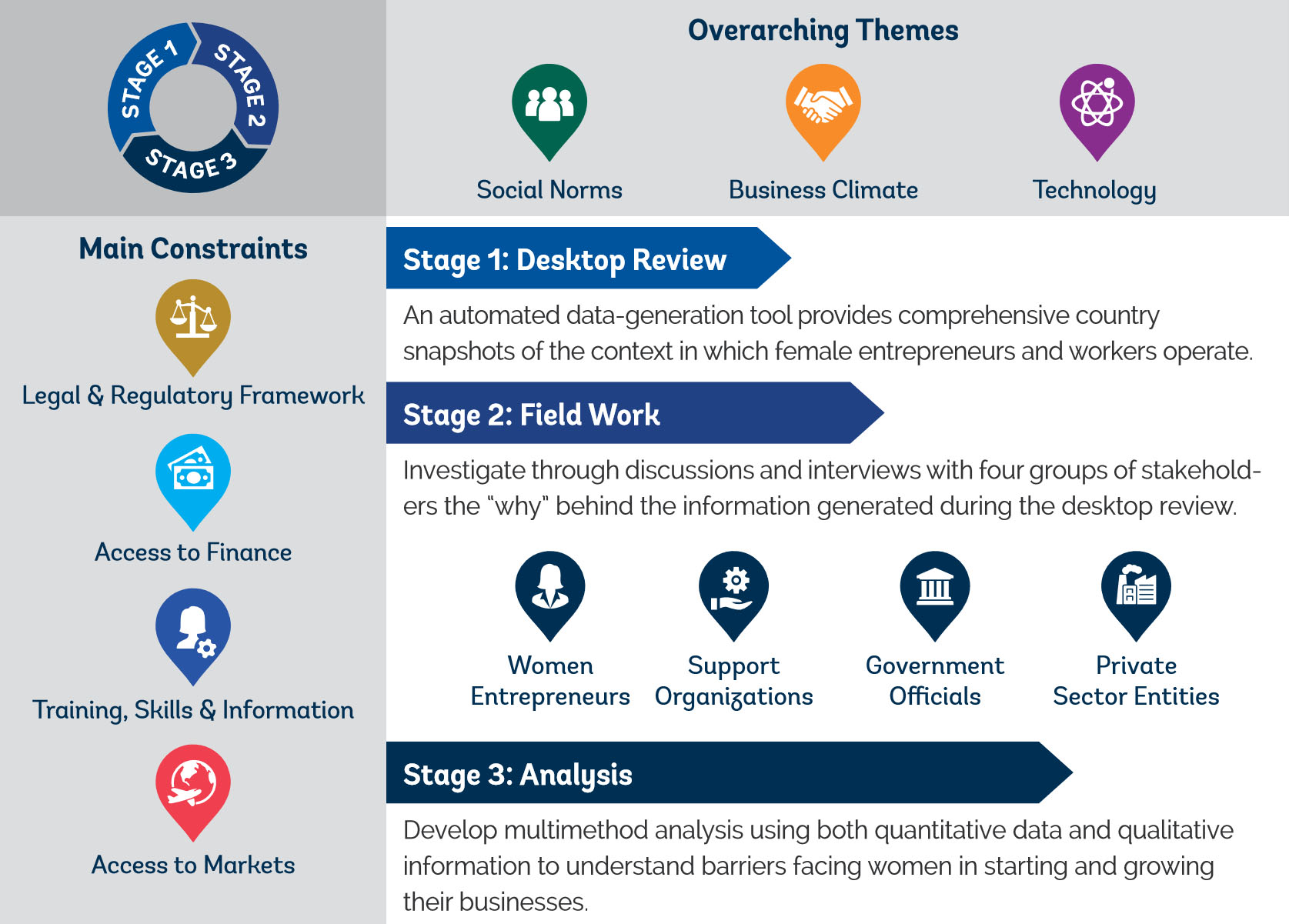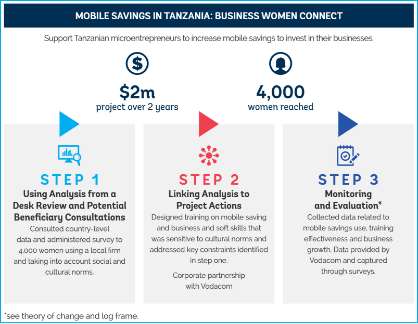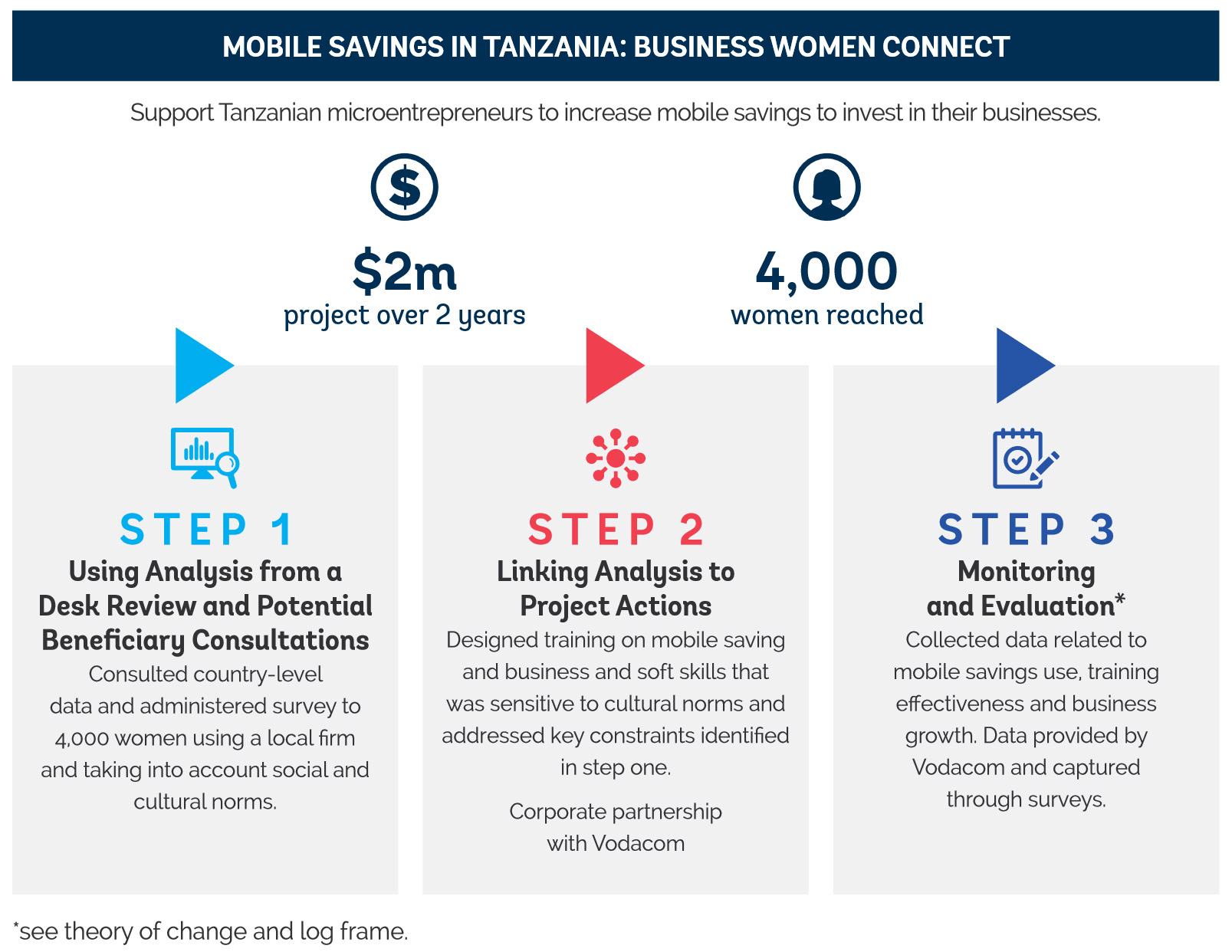Female Entrepreneurship and Technology Use
The focus on digital solutions to ease constraints to female entrepreneurship is based on the recognition that digitalization can have a tremendous positive impact for business owners — for women, in particular, given the specific obstacles they face — helping them to operate more effectively by increasing their knowledge of legal and regulatory provisions and facilitating access to finance and credit tools, training, skills, information, and new markets. For more information on incorporating technology into project design, click here.

About This Toolkit
Women’s economic advancement is critical to meeting key development goals and plays a central role for many development institutions, including the World Bank Group (WBG). To effectively design and implement interventions focused on women entrepreneurship — whether policies or programs — policy makers and project teams require effective knowledge and instruments.
This toolkit — Using Digital Solutions to Address Barriers to Female Entrepreneurship — responds to this need. It provides practical guidance to analyze, design, and measure technology-enabled solutions to advance women’s entrepreneurship. Its detailed instructions and resources are intended to help implementers to use thorough diagnostic processes to unearth key constraints to female entrepreneurship, including barriers to technology access and use. It also lays out intervention recommendations that incorporate digital technology — all illustrated by project examples. Finally, it provides a menu of indicators and advice for monitoring project results.
Provided here are a content summary of the Toolkit in a short presentation format and a PDF of the Toolkit. To go to a specific section in the report please continue to scroll down.
-
Toolkit At-A-Glance Slides
-
Full Toolkit PDF
Please note that this PDF file is static and reflects the original iteration of the toolkit. Some elements of the toolkit have since evolved and have been refined, based on pilots and practitioner feedback. Using the online version of all materials will be the best way to access the most up-to-date materials
Approach & Components
This toolkit provides practical guidance to help teams working on women’s entrepreneurship projects apply digital solutions to project design and policy advice. Such solutions may include, for example, recommendations to further women’s access to digital IDs or to implement online government services. It may also extend to specific community-level interventions, such as supporting women artisans in using e-commerce platforms and accessing online training. The primary audience for the toolkit consists of WBG project teams, but it can also be useful to governments, donor agencies, nongovernmental organizations (NGOs), and private sector stakeholders.
Key components:
Conceptual Background and Context
This section provides teams with a basic understanding of the status of women in business and of the benefits and constraints they may encounter in playing an entrepreneurial role, with an overview of the part technology can play in catalyzing women’s engagement.

Diagnostic Method
A DIAGNOSTIC METHOD, applied at the country level, based on some standardized and automated indicators, with a supporting analysis guide and a multi-method analysis tool to interpreting the data.
Quantitative data is rounded out by field-based discussions and interviews (conducted using discussion guides for stakeholder groups) that identify challenges and opportunities for women entrepreneurs. The method identifies challenges under four main vertical constraints and three overarching horizontal themes.
Data Analysis Guide
The sheer amount of data generated by the tool can be daunting at first glance. This guide is intended to help users assemble an overall picture that can then be developed in more detail, either from additional analysis of the data from the automated tool or by adding other sources, such as national gender reports.
Design Process
Provides menu-type options for determining the most relevant and effective interventions to support women entrepreneurs and for selecting actions, including identifying common obstacles and proven interventions to address constraints and deploy options from the menu of digital-based enablers within the four main constraint pillars. The matrix also indicates each intervention’s level of effectiveness, based on existing research and evidence.
Technology Criteria and DOs and DON'Ts
A set of technology criteria and DOs and DON’Ts for exploring the feasibility of deploying digital solutions within the local context, including methods for identifying and addressing potential obstacles to implementation.
Case Studies
CASE STUDIES that offer practical examples:
An entrepreneurship project that deployed a digital enabler.
A regional initiative that leveraged e-commerce to support female entrepreneurs.
Monitoring and Evaluation Guidelines
Monitoring and evaluation guidelines for tracking and measuring the results of policy reforms and digitally enabled interventions, including a menu of indicators.
Intervention Design Matrix
CLICK HERE to access the full Matrix, including features to create your own customized report by constraint, region, and level of evidence
Customize Your Content
Search report tools and information by constraint. Please click on the icon to go directly to relevant sections of the report.
Main Vertical Constraints
Download editable discussion guides, by stakeholder group, to customize sets of questions according to your project’s scope and objectives.
Discussion Guides
Further Reading
Get Involved
Post New Resources
Click here to leave comments, share tools and project examples, provide feedback and send resources that will enhance the toolkit and further increase its usefulness.








 Data Generation Tool
Data Generation Tool Data Analysis Guide
Data Analysis Guide Questionnaires & Interview Guides
Questionnaires & Interview Guides Multi-Method Analysis Tool
Multi-Method Analysis Tool Intervention Design Matrix
Intervention Design Matrix Technology DOs and DON’Ts
Technology DOs and DON’Ts Monitoring Indicators
Monitoring Indicators

 Legal & Regulatory Framework
Legal & Regulatory Framework
 Access to Finance
Access to Finance
 Training, Skills & Information
Training, Skills & Information
 Access to Markets
Access to Markets
